I did CrossFit for 15 Years and This is What it Did to My Body
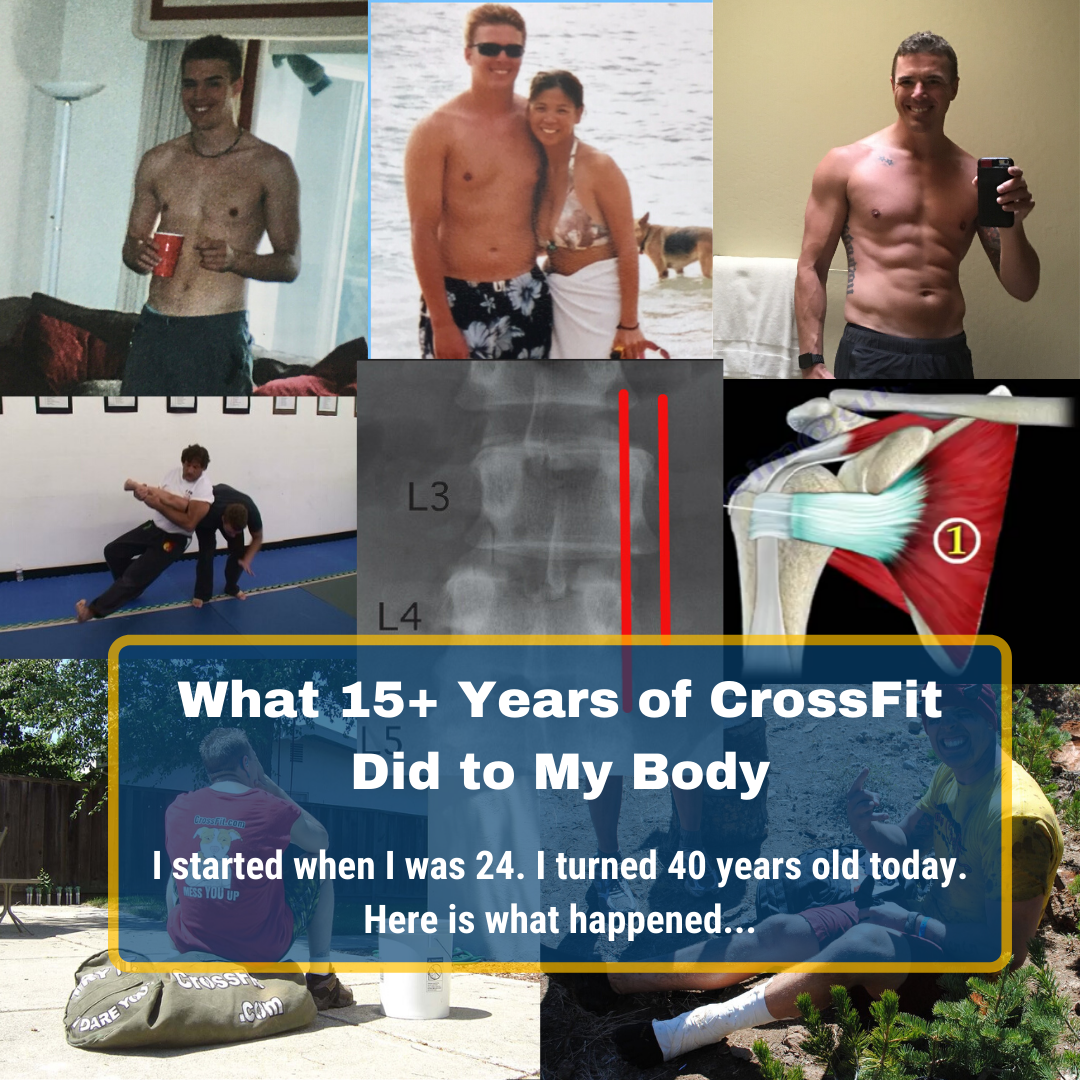
I started CrossFit when I was 24. I am writing this on my 40th birthday. I hate working out, and I have never had a membership to a gym (even though I have owned a more than a few).
It has been a crazy journey and I’d like to share some of my history, my mistakes, and what I have learned along the way. This is a ‘long one’ so make sure your coffee is topped off and/or you have your reading glasses handy.
TL;DR Notes
- We have come A LONG way since the early days of CrossFit. I was young enough to survive some (in retrospect) silly mistakes and now I get to take on the next 40 years with a body of knowledge and experience that will enable me to stay fit.
- Squatting below parallel, kipping pull ups, and ‘metcons’, didn’t ruin my knees, shoulders, or CNS.
- Most of my significant injuries have come from things OTHER than CrossFit. The few things that I did while doing “CrossFit” were completely avoidable and generally my own fault.
- When I was ‘sidelined’ by an injury or chronic issue, I was able to maintain my fitness through intelligent programming and the right amount of metcon.
- Programming and coaching matter. If you find something that is just 1% better than what you are doing now, the gains can be HUGE over time.

First, a little history…
It was the summer of 2004. “Dodgeball”, “The Notebook”, and “Napoleon Dynamite”, were in theaters (as well as “White Chicks” and “Chronicles of Riddick”).
Britney Spears, R Kelley, and Nickelback, all had songs on the top of the billboards (this seems more shocking to me than the movies).
YouTube hadn’t been created. Facebook was only for students at Harvard. Amazon only sold books. Blockbuster was MUCH bigger than Netflix.
It was 3 years before the first iphone would be released (almost everyone had Nokias or BlackBerries).
It was basically the dark ages.
I was working as a mechanical engineer and had been practicing/teaching martial arts for about 8 years. The place I was training had been involved with this ‘new’ thing where people did kickboxing and ground fighting at the same time (the UFC and MMA was just starting to become mainstream).
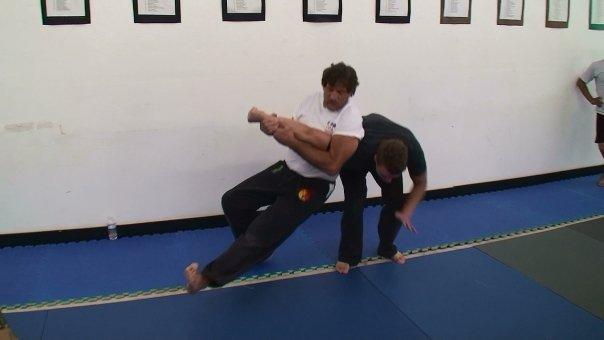
(This is me about to get my face smashed if I don’t roll out of it)
The first time I saw the word “CrossFit” was on a message board called “Bullshido”, a website for martial artists concerned more with real combat and exposing fakes and bad practices.
Someone’s signature (at the bottom of their posts) said “CrossFit. It is like cheating.”
Curiosity piqued, I started reading everything posted by Greg and Lauren on CrossFit.com.
After stalking the site for a couple months, I decided I would start in July. I had already been recruited for my first full contact Shootfighting match in July (we had to fly to Detroit since ‘no holds barred’ fighting was banned in my state). I didn’t want to upset my 12 weeks of training by trying something new, so I decided to put it off until after my match.
I weighed in at 190lbs (I am 6’3” and change) I won my first fight and was in the best shape of my life.
For conditioning, we did a ton of sparring, bodyweight stuff, and running.
For example, one of our regular conditioning routines was to do “The Deck of Cards”: With the deck face down, we’d flip one card over. If it was red, we’d do that number of push ups (3 was 3 push ups, Queen was 12, etc.). If the card was black, we’d do that number of air squats. Of course, it sucked when we got too many reds or blacks in a row. Going through the deck meant we’d do over 300 push ups and 300 squats.
There was no time component. A few times, we’d done two decks (although this took us close to an hour).
I believe I attempted a “WOD” during my training (one that I’d do well at), but the week after my fight, I tried and logged my first real CrossFit workout (July 3rd, 2004). Here is my post on the CF.com site:
Saturday 040703
Two rounds for score of:
Tabata Squats
Muscle-up for four minutes
Rest
No rest between finishing T. squats and muscle-ups. This is a 16-minute workout with rest at 8 minutes. Multiply lowest squat count for all eight intervals by the number of muscle-ups completed in four minutes for each round and post to comments. Substitute 5 pull-ups and 5 dips for each muscle-up if necessary.
I did it in my apartment. I couldn’t do muscle ups (obviously), and I didn’t have a place to do pull ups, so I did assisted dips in my galley kitchen with my feet on the opposite counter.
And yes. You read that correctly… My first CrossFit workout was TWO full bouts of Tabata squats.
Keep in mind that I was doing A LOT of air squats for my fight training. I believe I hit 20 as my lowest set of squats (although I doubt they were full depth).
Aaaaand I couldn’t walk right for the next 5 days.
I am pretty sure that if I went in to get my blood checked at the hospital, I would have had what they would consider “Rhabdo” (which is a term that didn’t exist in the CrossFit world yet).
“WHATTHEFUCKISTHIS!?” I asked myself.
I was in the best shape of my life! This 16-minute workout left me more beat up than any training session or fight I’d had up to that point.
Now let me digress for a moment.
When you are doing submission fighting, there is something weird that happens to your perspective. When someone does something that ‘hurts’ in training, you immediately want to know what it is. You want to figure out how to do it, and how to get out of it. You want to know MORE.
CrossFit triggered this in my brain.
I HAD to know more about this. How could this destroy me so much!?
After recovering somewhat, I attempted a workout and posted my results the following week. You may have heard of it:
Tuesday 040706
"Fran"
Three rounds, 21-15- and 9 reps, for time of:
95-pound Thruster
Pull-ups
I took my threaded 1” diameter bar (some barbells have threaded ends where you screw on a nut to keep the weights in place), and my “Ted Williams” Sears concrete filled plates I inherited from my dad who used them in the 60s.
Here is the second workout result I ever recorded:
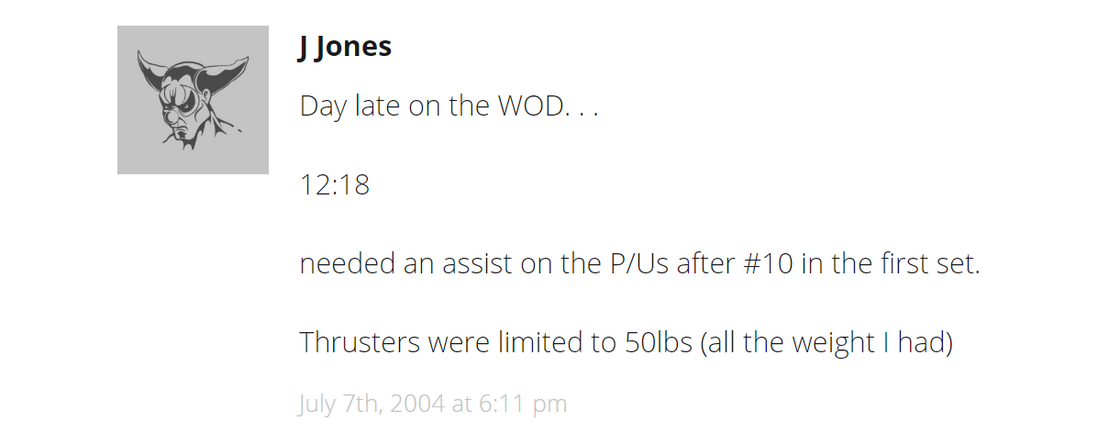
J Jones
Day late on the WOD. . .
12:18
needed an assist on the P/Us after #10 in the first set.
Thrusters were limited to 50lbs (all the weight I had)
(The funny thing is, I didn’t count the bar weight because I didn’t know that was a ‘thing’ until I spent more time training. I only counted the weight of the plates).
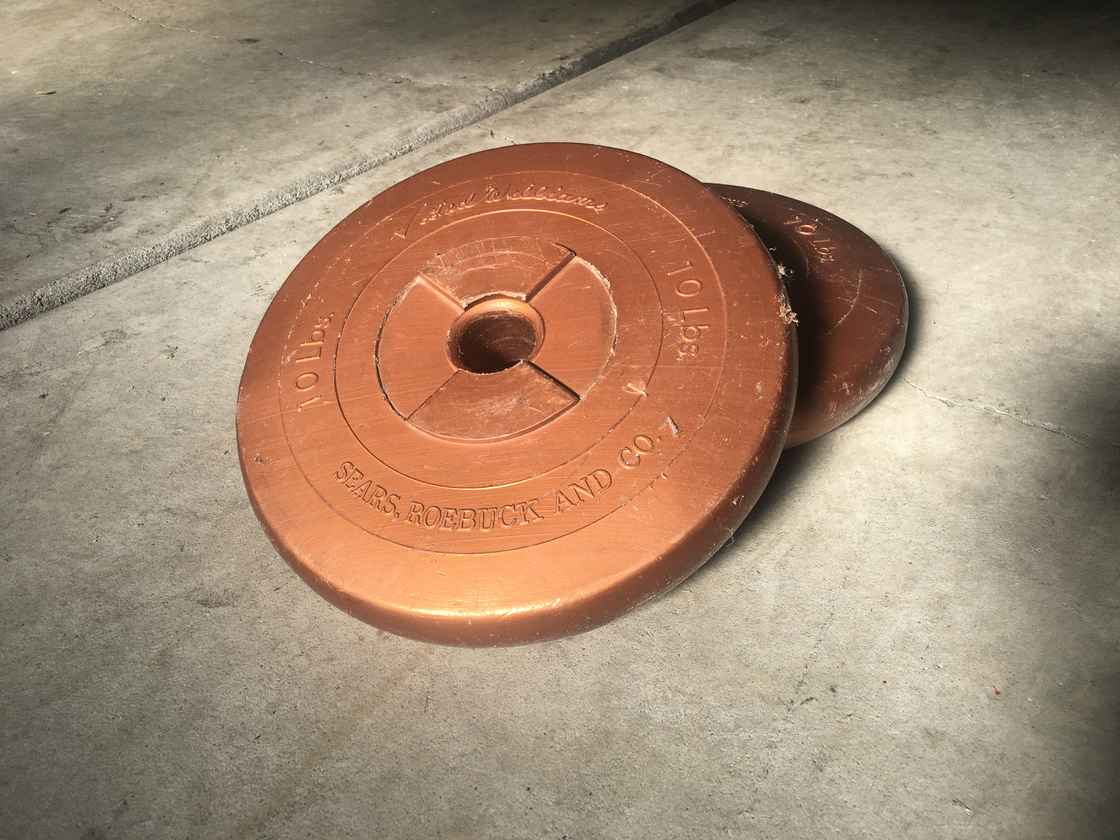
(I still have the plates!)
I.Was.Hooked.
Over the next few months I did about 3-4 CrossFit workouts per week on top of my normal training.
I didn’t pay much attention to diet, I just followed as closely to the 3-on-1-off schedule as possible and ate as much food as I could get (I was 24 years old after all).
I was refereeing a fight in early October that same year, and we were weighing in fighters.
I tested the scale we were using by stepping on it, and it said 212 lbs! I thought “THERE IS NO WAY WE CAN USE THIS. It is way off!” But the other people said is about what they expected.
I went home and checked my own bathroom scale, and yup… I had gained 22lbs in 3 months.
Holy Hypertrophy!
Clearly not using the barbell before CrossFit was affecting my development!
The next few years consisted of trying to learn the Olympic lifts from CrossFit.com slide shows and the only VHS tape in existence that taught the lifts (and possibly, the most BORING video in existence… Remember that YouTube wasn’t around yet). Teaching myself to kip. Substituting something in almost every workout because I was training on my own in the Dojo and my apartment patio.
I found a Kettlebell online and paid exorbitant fees to ship it. After nearly paralyzing myself failing on an overhead squat with my threaded bar and trying to not drop the weights, I ordered an Olympic bar and bumpers from “Bigger Faster Stronger” for about 4x what they cost today. I almost ‘bounced’ them off my 3rd story patio a couple times.
I met up with Mike Minium (who eventually started CrossFit Oakland in 2005 and is one of the oldest affiliates to date) and drove to the original CrossFit Headquarters in Soquel on Sundays to get my first muscle up and fawn over Greg Amundson, Annie Sakamoto, Eva Twadarkens, and Nicole Carrol. As well as to suck up as much info as possible from Greg Glassman. My wife and I received a wedding gift of a CrossFit Certification Seminar. Good times.
I also found the only other guys in my town doing CrossFit (Rob Barnum and Craig Howard) and we started getting together for WODs. In 2005 we launched “Diablo CrossFit” in my backyard (I had a backyard instead just an apartment patio at this point).
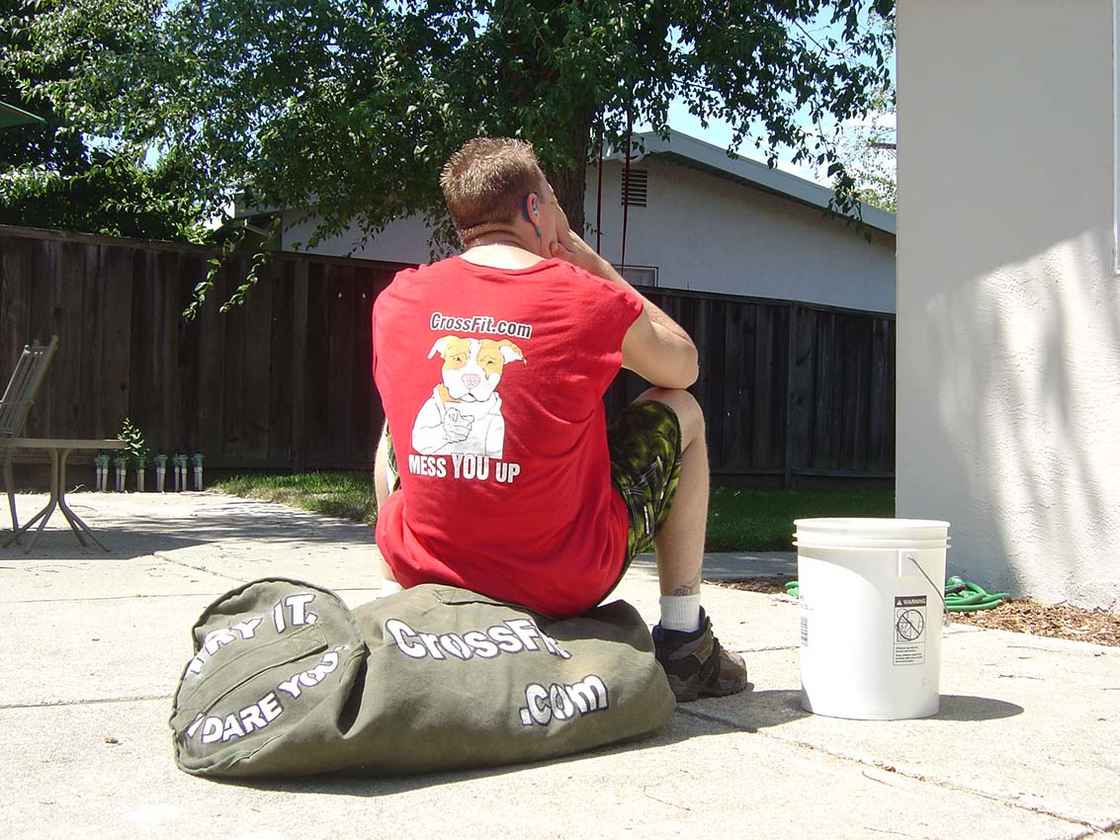
(The original ‘backyard’, the rings hanging in the tree in the background is where I did 50 unbroken kipping pull ups the first time)
Eventually we moved to a park and then a 1000 square foot warehouse. We used to make up the workouts each day, but in 2006 I took over the programming, creating workouts 7 days per week.
The story of how Diablo grew to multiple locations, 1000s of members, 28 classes per day, and podium finishes at the CrossFit Games, is another story…
This is about my journey.
When I started CrossFit, it was all about ‘measurable and repeatable’ workouts using functional movements to make you better at activities outside of the gym. I liked it because I could measure progress (because engineers like data) and because I didn’t have to spend hours in the gym training each day.
From 2004 to about 2008, there was no such thing as “CrossFit Competitions” (other than a couple exceptions, but they were very different than competitions today).
We all did CrossFit to be good at other things, to look good with our shirts off, and because it was more ‘fun’ than regular gym training.
In 2008-2009 I started to focus my training more on competitions and less on my MMA fights. It probably had something to do with the fact that when you move into your 30s, getting punched in the face is not as fun as it was when you are in your 20s.
I went on to compete in the Games/Regionals (back when it was much easier to participate), but quickly realized that focusing on my own training and performances would not enable me to help as many people as possible (my original reason for starting the gym). I kept my training aggressive so I could ‘compete’ on certain movements with my athletes, but my focus was on programming and coaching.
Bumps Along the Way (The Injuries)
When I started CrossFit, the prevailing wisdom was that squatting below parallel was going to ruin my knees. That kipping pull ups was ‘cheating’ and would wreck my shoulders. And that CrossFit was just a “Fad” and it would never stick around.
My knees are fine. I can sit in the bottom of an ass-to-grass squat for minutes without pain. I have ‘better than average’ shoulders (according to recent visits to a Physical Therapist) and I can still rep out 35+ consecutive kipping pull ups (if I want to). This includes the fact that at one point (while training to do 50 unbroken pull ups), I was doing 100-140 kipping pull ups EVERY DAY for about 3 months (I even brought rings on my honeymoon to Australia that I hung in a tree to practice). Didn’t have any issues from that, and I still don't now have any issues now!
Here are my significant the injuries I have suffered during my CrossFit experience in order of appearance.
Plantar Fasciitis
My first significant injury came from doing sprints in Chuck Taylors without warm up. I felt a sharp pain in the bottom of my foot (like I stepped on a rock, I literally took off my shoe and checked that there wasn’t a rock in there). I hadn’t been working out in Chucks much, and I didn’t warm up.
This one took a while to recover from. Lots of taping. Wearing different devices to bed. Rolling on frozen water bottles, etc. I had to work around it quite a bit, but I was still able to train using other parts of my body. It only got better with time and rest. No more issues today.
Lessons Learned: Warm-ups are important (even when you are young and spry). Use appropriate gear for your ability.
Blood Poisoning
In 2007 I attempted the ’30 muscle ups for time’ WOD. I ripped my wrists using a false grip. I didn’t think much of it at the time, but the day after while I was at a birthing class with my wife, I started to have a fever and get dizzy.
The rips on my wrists had become infected. I ended up with blood poisoning and trip to urgent care.
Lessons Learned: If you think you injured yourself, STOP. Especially if there is an open wound. Rips are completely avoidable. And keep your equipment clean and disinfected.
Sub Scapularis
We hosted an Olympic Lifting seminar at the gym. After 2 grueling days of lifting drills, we were encouraged to try and see if our maxes had improved. I really wanted to get past that 200lb mark so I kept making attempts even though I should have stopped (back in 2010, a 200lb snatch was pretty good).
While trying to receive a snatch at the bottom of a squat, the bar started to go behind me. I fought to keep it overhead when I heard a tear under my armpit (under my left arm).
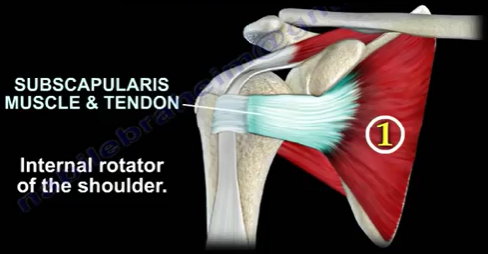
I had injured my sub scapularis. A small muscle that helps stabilize the shoulder. I had trouble buckling my seatbelt for the next few months. It got better and I was able to hit 225lbs not long after.
Lessons Learned: Don’t do risky things when you are fatigued. Don’t let your ego get involved if you aren’t feeling 100%.
Wrist Impingement
Turkish Get Ups were cool for a while but hit their peak when internet videos became a thing. I wanted to see how much I could do. After doing 135lbs on my right hand, I tried to do my left.
Everything was fine until I lost it about halfway though.
The problem is that my forearm is longer than the radius of the bumper plates. This meant that when I came down, the 135lbs was caught between my wrist and my elbow (the bumper plates didn’t hit the floor but my elbow did).
My left wrist took about 5 months to finally feel normal again. No issues after that.
Lessons Learned: Don’t do dangerous things that won’t make you better. Make sure you have a safe set up (equipment and environment-wise) if you are going to attempt something ‘risky’.
Broken/Dislocated Ankle
Before ‘Obstacle Races’ were a thing, there was this new event called the “Tough Mudder”. Their first event in California was in Bear Valley. From our gym, we recruited one of the largest groups to attend.
They had a ‘slide’ event where people slid down the plastic visqueen (tarp) into the water reservoir near the top.
I thought it would be a good photo op if we all went down like it was a toboggin. 13 or so of us lined up and I was second in line. The plastic had come loose at the bottom. As we came down at speed (11 people behind me) my foot got wrapped up in the loose plastic.
My ankle was ripped behind me as all 11 people started to land on top of me (while I was under water). I was able to escape without intaking too much water, but my ankle was trashed.
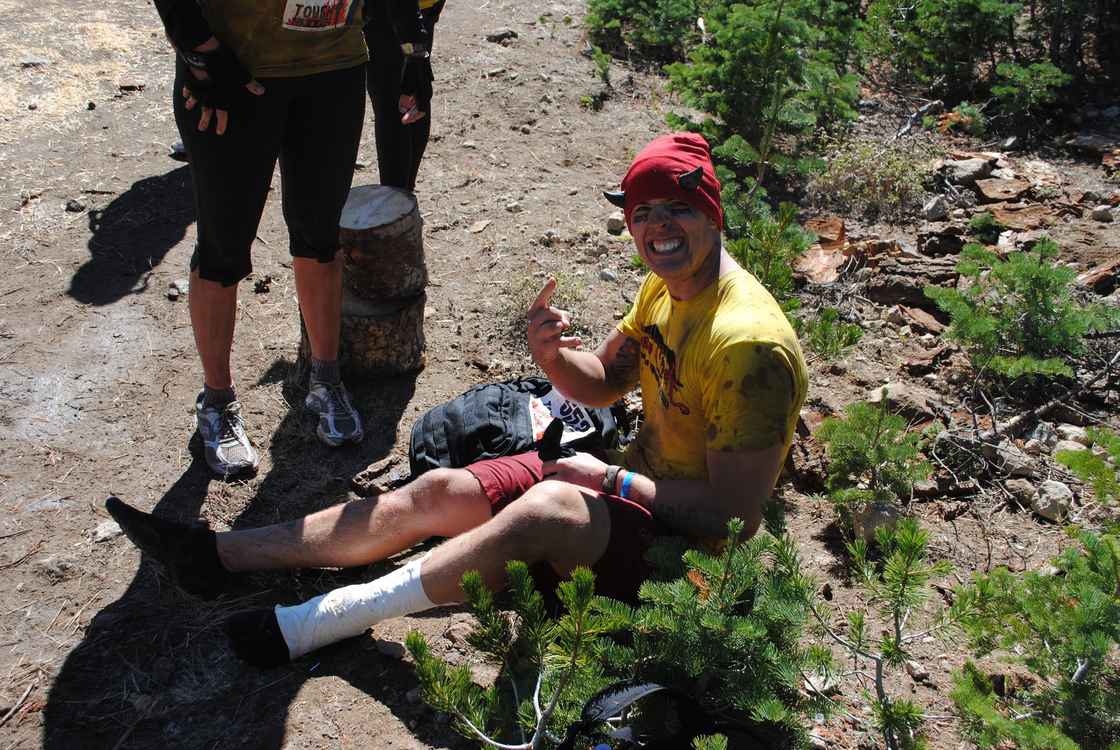
(Why I was too stubborn to walk the rest of the race without assistance, I will never know.)
I taped it up and used a stick to finish (another 2 miles or so). When I got back to see a doctor, 9 ligaments were completely torn and I was looking at 12+ weeks of rehab.
I should have gotten a second opinion on the rehab. I am dealing with issues today because I do not think the prescribed recovery was best for my situation.
Lessons Learned: Don’t do ‘cool’ stuff if you aren’t sure of the situation. Get a second opinion on rehab. Training around a lower leg injury isn’t that difficult… Also, you get to cut in line at Disneyland if you are wearing a boot and driving around in one of those scooters.
Torn Psoas / Nagging Low Back Pain
I saved this one for last for a reason. It has been the most chronic and hardest to work around injury.
Originally, I injured my back while teaching a kickboxing class. I believe it was in 2006.
I was kneeing a pad while demonstrating and felt a significant ‘rip’ in my hip. Behind my organs really.
I was able to limp through the rest of the class, but soon after I started to have significant back pain. I didn’t realize it was related until much later.
The combination of martial arts, sitting at a desk, and doing CrossFit while being ‘quad dominant’ meant that I was doing a number on my low back. My hip flexors and psoas were trashed.
After about 6 months of trying to work around it, I finally saw a Doc who figured out it was a hip issue (a Chiro who did CrossFit). I started doing some rehab and stretching and that enabled me to keep working around the underlying issue for years.
It finally caught up to me in 2014.
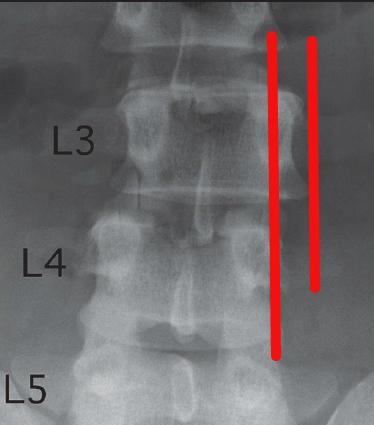
(Not my personal x-ray, but this shows what it looked like)
My back started ‘locking up’ on me regularly. I would be bed ridden for a few days after each incident. I got an x-ray and it showed that my L3 had shifted over ¼ of an inch (mind you, at this point I was snatching 225lbs, deadlifting 420lbs for reps, and back squatting in the mid 300s).
I decided that my ‘keep up with the competitors somewhat’ days were over, and I shifted to ‘workout-as-little-as-possible-and-still-look-fit-and-do-cool-shit’ phase.
5 years (and multiple doctors) later I have finally started fixing my back/hip issues.
I have been compensating for so long, I have muscles that never turn off and I am not firing the correct muscles for stabilization. The progress just in the last couple months has been awesome. I can’t wait to get back to heavy squatting and deadlifting!
Lessons Learned: The body is a compensation machine. After the initial injury, it found ‘work arounds’ to keep me performing at a decent level. This is a double-edged sword. It kept me fit and having fun, but it also meant I was engraining movement patterns and sequencing issues that would only make things worse over time.
I should have worked through the issue early on, then made sure I wouldn’t continue to compensate. I should have kept coming back to get checked even when I thought things were ‘fine’.
I also learned that even with back pain 24/7 (after those 2014 incidents), I was still able to do “CrossFit” by customizing my workouts and programming.
Where I am at Today
Currently, I still hate ‘exercising’.
When I was doing sports, and especially when I was fighting, working out had a purpose.
I worked out so I wouldn’t get my ass kicked (figuratively and literally).
Over the last few years I have continued to use CrossFit methodology to stay healthy while working around my limitations and working out as little as possible.
Coming into my 40th birthday, I decided to track my habits, my performances, and get a slew of tests done to see how the last 15 years have been treating me (‘you can take the engineer out of the office, but you cannot take the engineer out of the man’… i.e. data is king).
Current Stats
I have tested these over the last few months to see where I am at.
Height: 6’ 3.5”
Weight: 205lbs
Body Fat %: 10.7%
20 ‘Unbroken’ Strict Pull Ups
Weighted Pull Up: 100+ lbs
7 mile run on the beach (the most I have run in my entire life): ~1 hour
Single Dumbbell Shoulder Press: 65lbs for 5 reps
Strict Ring Dip: 21 reps
Split Squat/Lunge (DB Front Rack): 130lb for 10 reps (no squat or deadlift because of back issues)
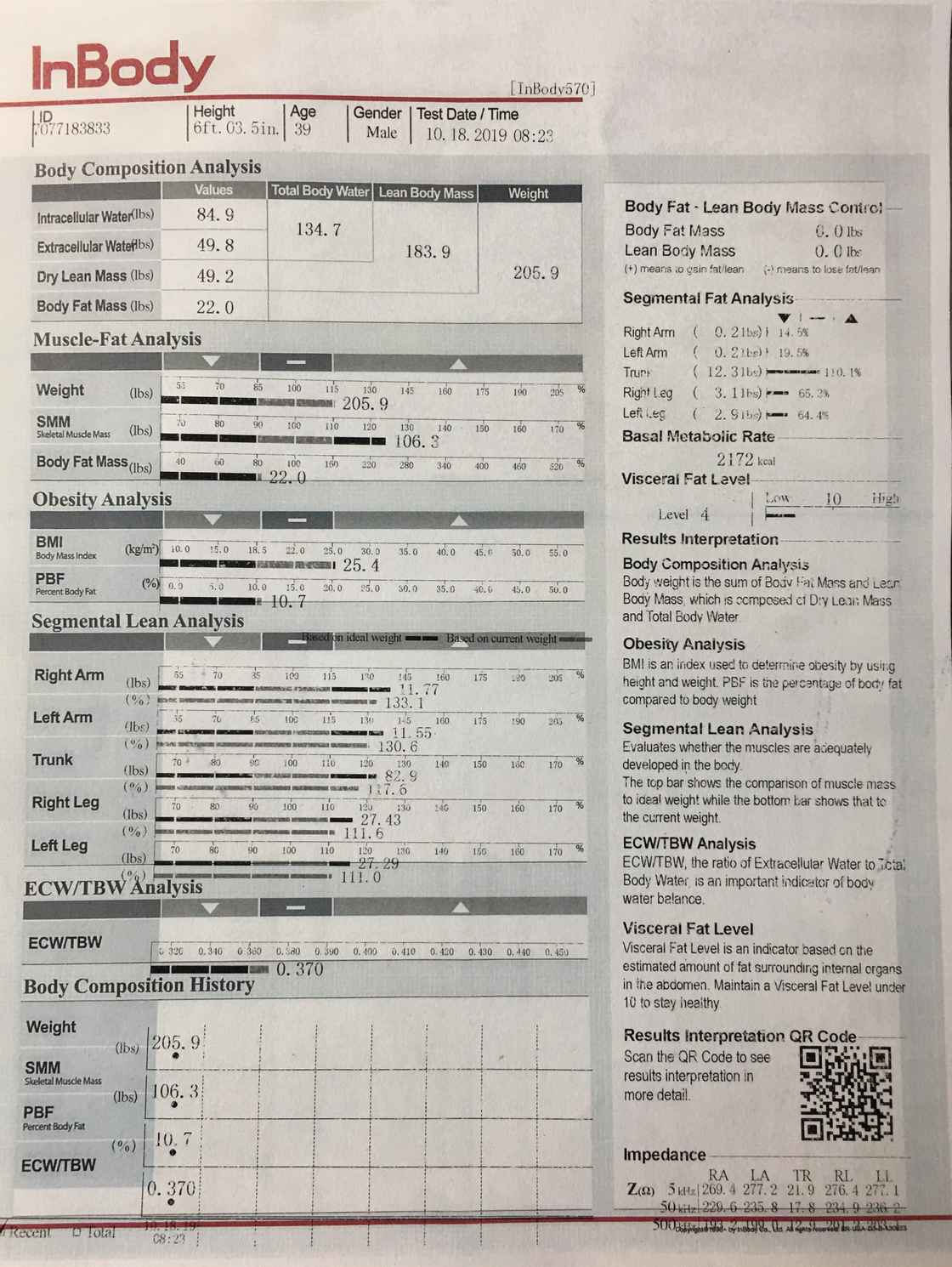
(My InBody scan from a couple weeks ago)
Recent Bloodwork
My blood pressure is great and my bloodwork came back with good marks. BP is 101 over 64. And 63 BPM resting.
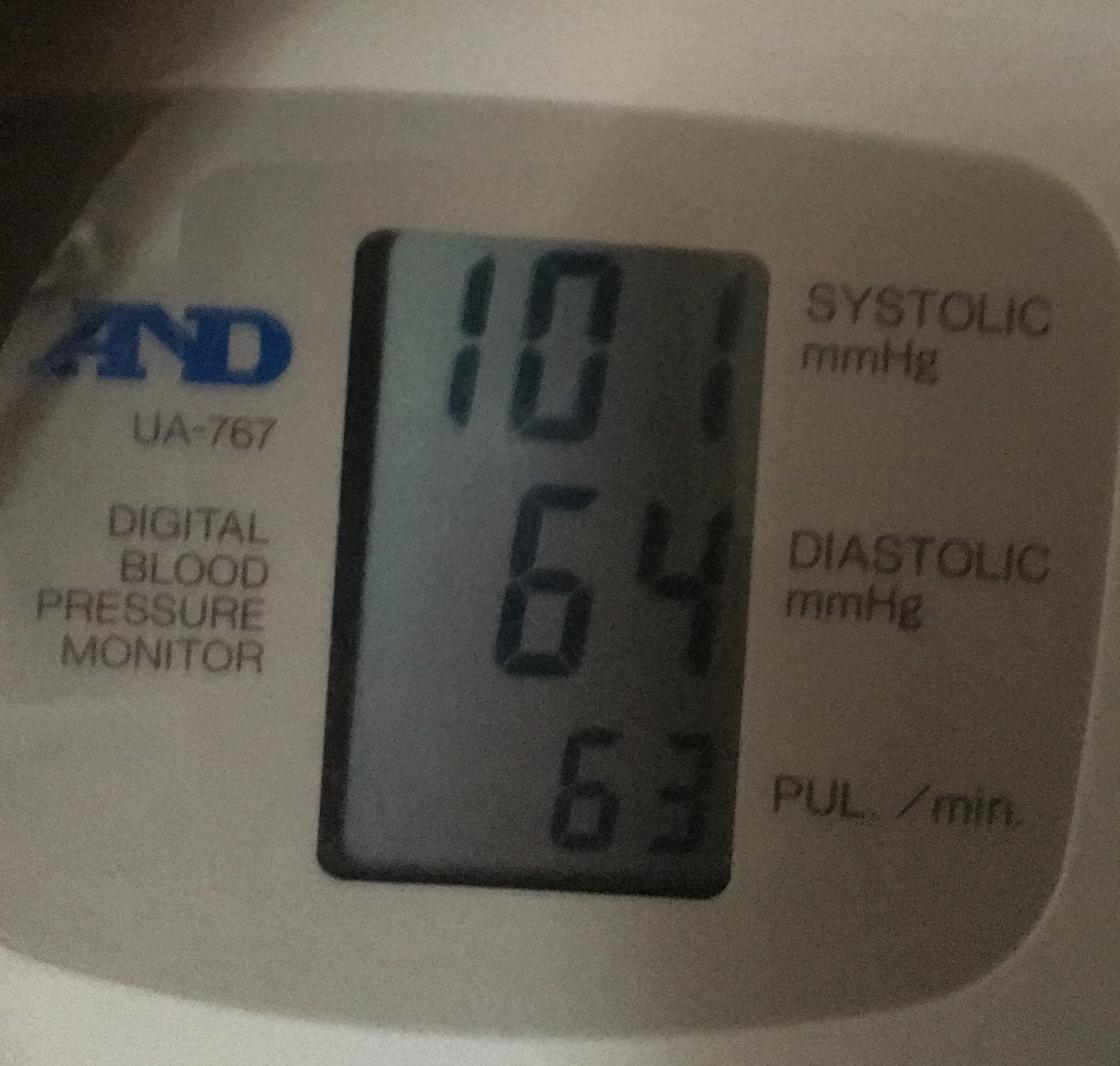
My Doc said my cholesterol numbers for LDL are probably high because of my diet, and the testing method used is the formula one (not the one where they actually test, but it is calculated based on ‘standard’ formulas that don’t always work for people eating low carb high animal protein).



(I went ahead and had them check my testosterone levels to see if anything was amiss... All good here too!)
Training Frequency
I workout about 2-3 times per week. Usually I spend about 5-15 minutes on warm up and mobility/activation, do some something ‘heavy’, then do a circuit that will tax my cardio-respiratory system before finishing with a 1 mile walk or easy bike ride. Total time: about 3-4 hours per week.
I will then fit in a trail hike (run, ruck march, or walk) about once every week or two.
I also take every advantage to ‘play’. Do something new, pick up an old skill, etc., as often as possible (right now, 2-3 times per year).
And that’s it!
There are weeks where I’ll go 3-5 days without leaving my house or working out. Occasionally, I won’t do any lifting or metcons for a week or so. I don’t even realize that I haven’t been using my standing workstation or going outside. I am too ‘plugged in’ to my work or reading/learning (remember that I do not enjoy the ‘fitness-ing’).
Food
According to my food scale and My Fitness Pal, I eat about 1,800 - 2,200 calories during the week and 3,200+ on the weekends (2,300 on average across all 7 days)
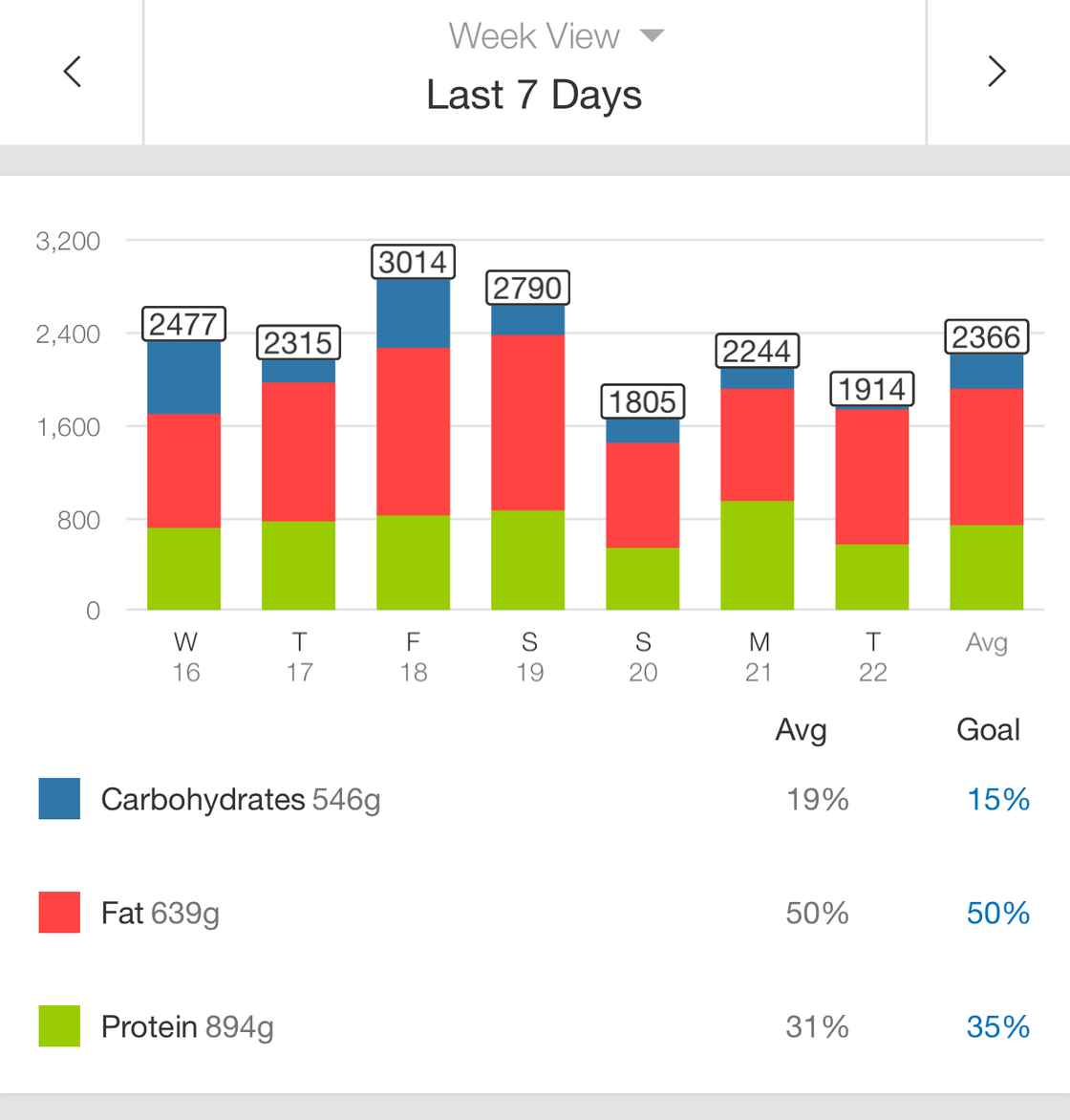
I drink booze regularly (usually ‘low carb’ ciders and non-gluten liquors like rum and tequila).
I don’t eat gluten or corn because I have a legit allergy.
I average about 150g of protein per day, less than 50-100g of carbs per day, and 100g of fat per day. My macros end up being about 30-35% protein, 45-50% fat, and 15-20% carbs.
I take supplements for Vit C, Vit D, Betaine HCL (a digestive aid), Vit B, Glutathione, NAC, Curcumin (turmeric), and Omega 3s.
I practice ‘Time Restricted Eating’. I’ll try to get my first meal around 10 or 11am and then finish eating by 8pm.
Sleep
I am a BIG proponent of good sleep. I try to sleep 8+ hours a night. I limit light exposure when I can (especially hand held electronics) before bed. I take a nap most days (~20 min). My room is pitch black and there is no light pollution from clocks, TVs, etc.
Biggest Things I Have Learned (Training Myself and Others Who Have Been Doing My Programming for the Last 10+ Years)
Metcons. HIIT (High Intensity Interval Training). Embracing the Suck. Etc. Have their purpose. BUT…
They are not a panacea that will cure all health/fitness related goals.
They are potent signals we can send our bodies to create positive adaptation, but they have their limits. Unless you plan on competing in the ‘Sport of Fitness’, you will not benefit from doing hard metcons more than 3-4 times per week.
I believe that a similar effect to my experience of “OW OW OW! Do that again!” took over the CrossFit world for a while.
‘That 15-minute workout was good, a 30-minute must be better!’ some people started to think.
‘That workout made me SO sore. It must be a good one!’ is another thing that people started to chase.
While recognizing the benefits of intense metcons, people started adding more thinking the benefits would also increase. But they forgot ‘it is the dose that makes the poison’.
A little bit of metcon goes a long way. A little bit more is probably fine (doing them more frequently, but shorter duration for example). But once you hit a certain saturation point, you will stop getting a return on your investment.
Go past that, and you’ll start going backwards and even injuring yourself.
This is one of the core components of Thrivestry. We not only dial back the metcon volume compared to most other programs, we also prescribe a “Context” (article here) so people know when to go hard, and when to focus more on practice.
Do something ‘heavy’ or challenge your technical skills EVERY Session
The human body is LAZY. If we do not challenge it frequently, we will get bored and not adapt.
If you are going to invest some time in a workout, make sure you are challenging more than one ‘system’ (not just the metcon engine or cardio). A little strength and/or skill work before your metcon will go a long way. On the flip side, a little metcon after your strength stuff will keep you trim and able to do more stuff outside of the gym.
Train for better performance at life, eat for better body composition
Start with consistent training so you can move better and take advantage of any physical challenges that occur. Then start tweaking your food so you are happy about your body’s appearance.
Keep in mind that exercise is a means to a goal. For most people that goal is live as long as possible (and to stay sharp minded and ambulatory the whole time).
Stick primarily with movements and programming that is going to make you stay in the game of life as long as possible – NOT the movements and programming that is purely for ‘gym performance’ sake. It is okay to ‘play’ in the gym with different or challenging gym movements but be aware if you are starting to focus on stuff that isn’t going to make your life better outside of the gym.
And you can’t out-train a diet that isn’t suited to your physiology.
I am a firm believer in the fact that everyone has to find the right combination of variables that works for them. Keto. Low Fat. Low Cal. Vegetarian… there is no one ‘right’ answer for everyone. The only way to find out what works is to keep making small tweaks and tracking changes.
That being said… Just about everyone agrees: You need to eat more vegetables. Be aware of how much sugar you are intaking. Drink more water (and drink less calories). And get enough protein.
Sleep is a health multiplier
No amount of training or dieting will work properly without adequate sleep. Clean up you sleep habits and they will ‘multiply’ your training an food efforts.
You can train around any limitation
One of my favorite parts about CrossFit is that it enabled me to train around injuries/setbacks. It helps that I was a coach and programmer (so I could always find a solution to get something done).
The key to making it work is to have someone with experience guide you, to not over-do it (overtrain the other stuff you can still do), and to not let your ego beat you up because you can’t do what you once did (yet).
If you are looking for a ‘cheat sheet’ to work around an arm or leg injury, you can download a free one here…
Coaching and programming matter
In the early days, we made things up as we went following some basic principles. We figured things out, learned from each other, and refined everything over time.
The longer I do this, the more I am convinced that getting good coaching is critical for newer folks and important for experienced people as well. Find a good coach, invest in yourself and pay them what they are worth.
Programming is also crucial across the spectrum of experience levels.
CrossFit is unique in its power to get fast results, even when halfway decent workouts are picked ‘randomly’.
Do not confuse this ‘side-effect’ as all there is when it comes to programming.
Good programming goes beyond the initial people starting out and gets results for decades. Good CrossFit programming makes people fitter outside of the gym. Good programming doesn’t make ‘less fit’ clients feel like losers because will never do the workouts as written. Good programming isn’t watered down competition programming.
There are a lot of great programs out there, but there are many more that could be better.
Programming and coaching are principles that follow the 1% better every day law from James Clear.
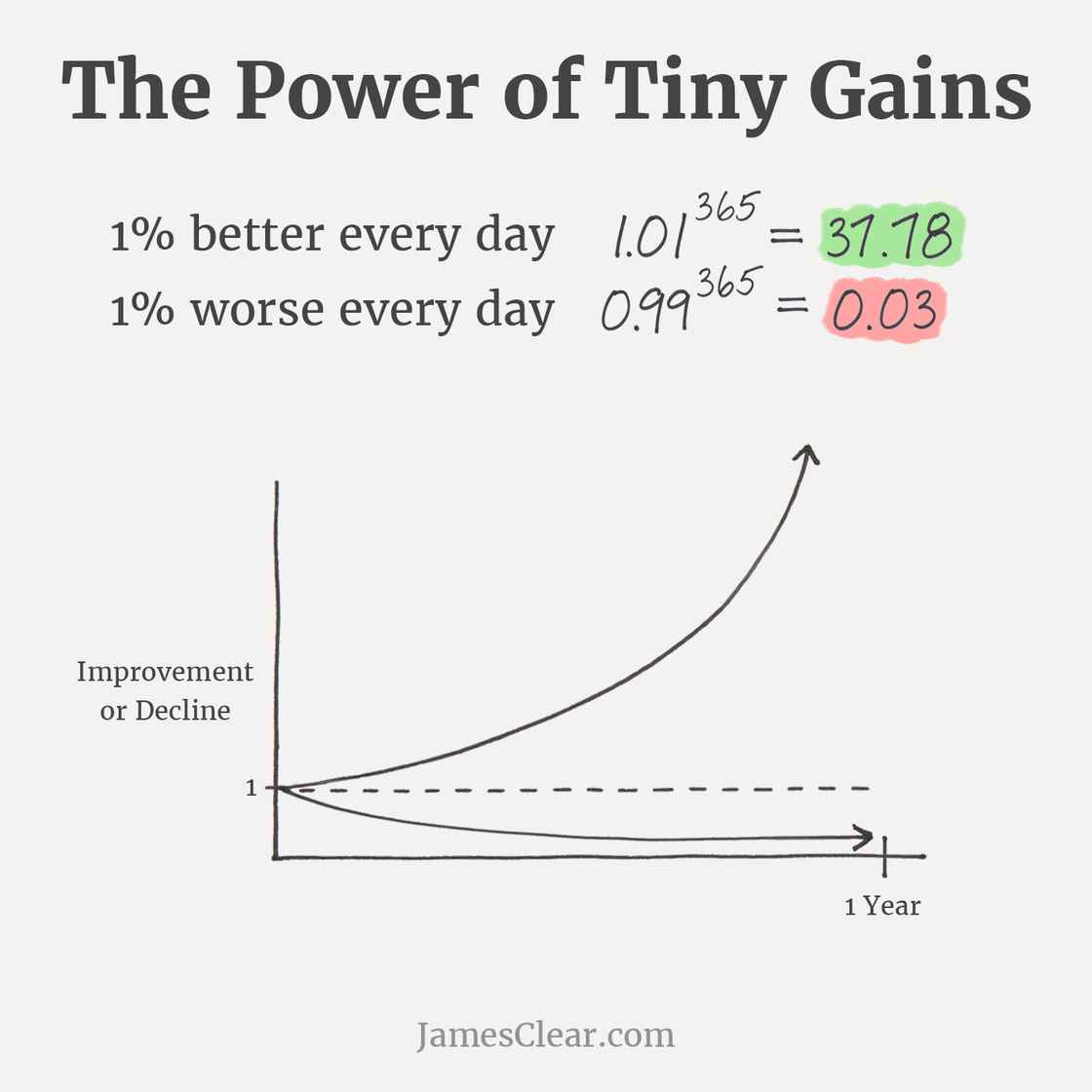
If a good coach and/or a good program can make you just 1% better per day on average than a different coach/program. The gains can be enormous.
(Just be ready to have that coach/program make you do the things you don’t like to do. It is sort of their job).
Final Thoughts
I am about to hop on a plane and leave for Costa Rica for my 40th.
I might workout a day or two. I will definitely play in the waves, go on some hikes, and probably drink my weight in booze. I will also spend quality time with some of my closest friends while talking about fitness as little as possible (I probably will still talk about it some. I can’t help myself).
Thank you for joining me on this little jaunt through 15 years of CrossFit training (and Congratulations for making it to the end). Please feel free to share this with anyone who might find it useful.
If you found this through Facebook or wherever, I’d really appreciate it if you drop a ‘like’ and or a comment. It really does help spread the message around the interwebz.
If you are interested in learning about a ‘new’ type of training that I have been experimenting with (that ties into the whole CrossFit thing nicely), drop your email and you’ll get notified when it is ready for launch.
Thrive on.
-jj
Please share this if you found it useful or if you think it might help someone else.
Here are a few other things you may find interesting:
Using the Context of the Programming for Longevity and Getting out of Ruts
The context is the recommended overall approach to the class that day. Without a planned approach you will likely stick with the same default approach you are comfortable with and you will not get the most out of your training.
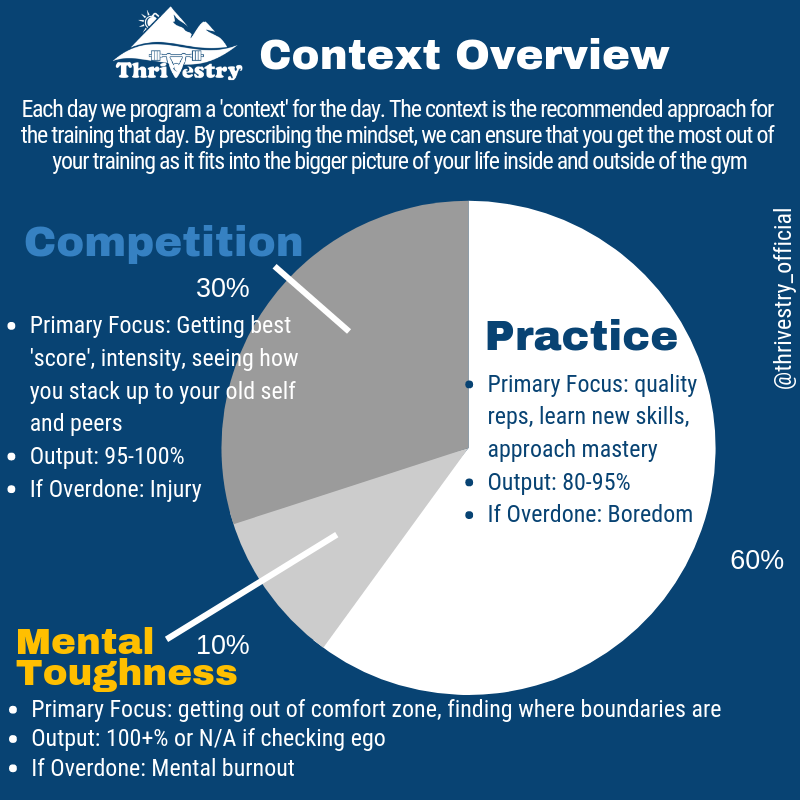
EDC, GPP, Marie Kondo, and being prepared for anything
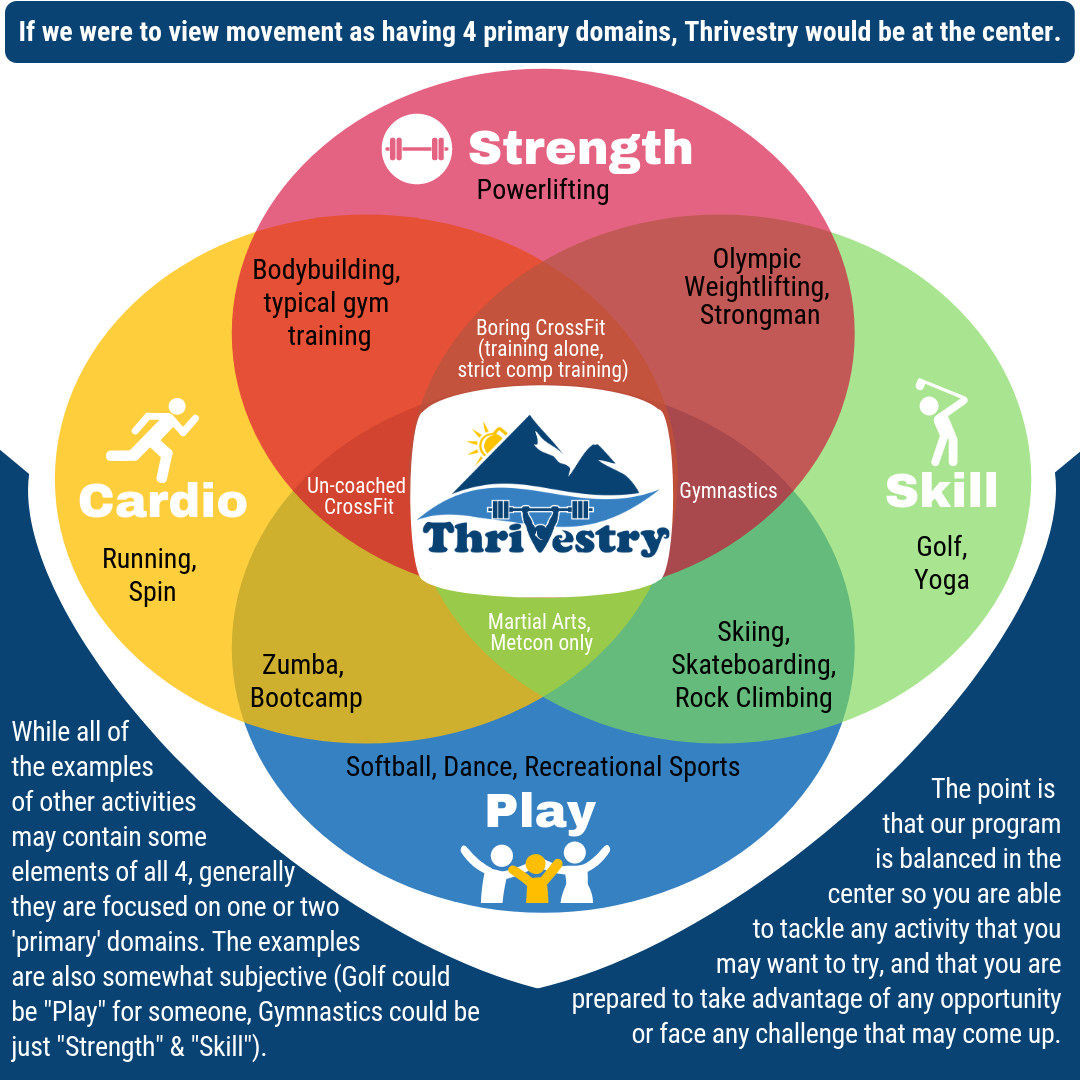
EDC stands for “Every Day Carry”. It is a term generally used for what items a person tries to bring with them every day so they can be prepared for life’s unknown and unknowable.
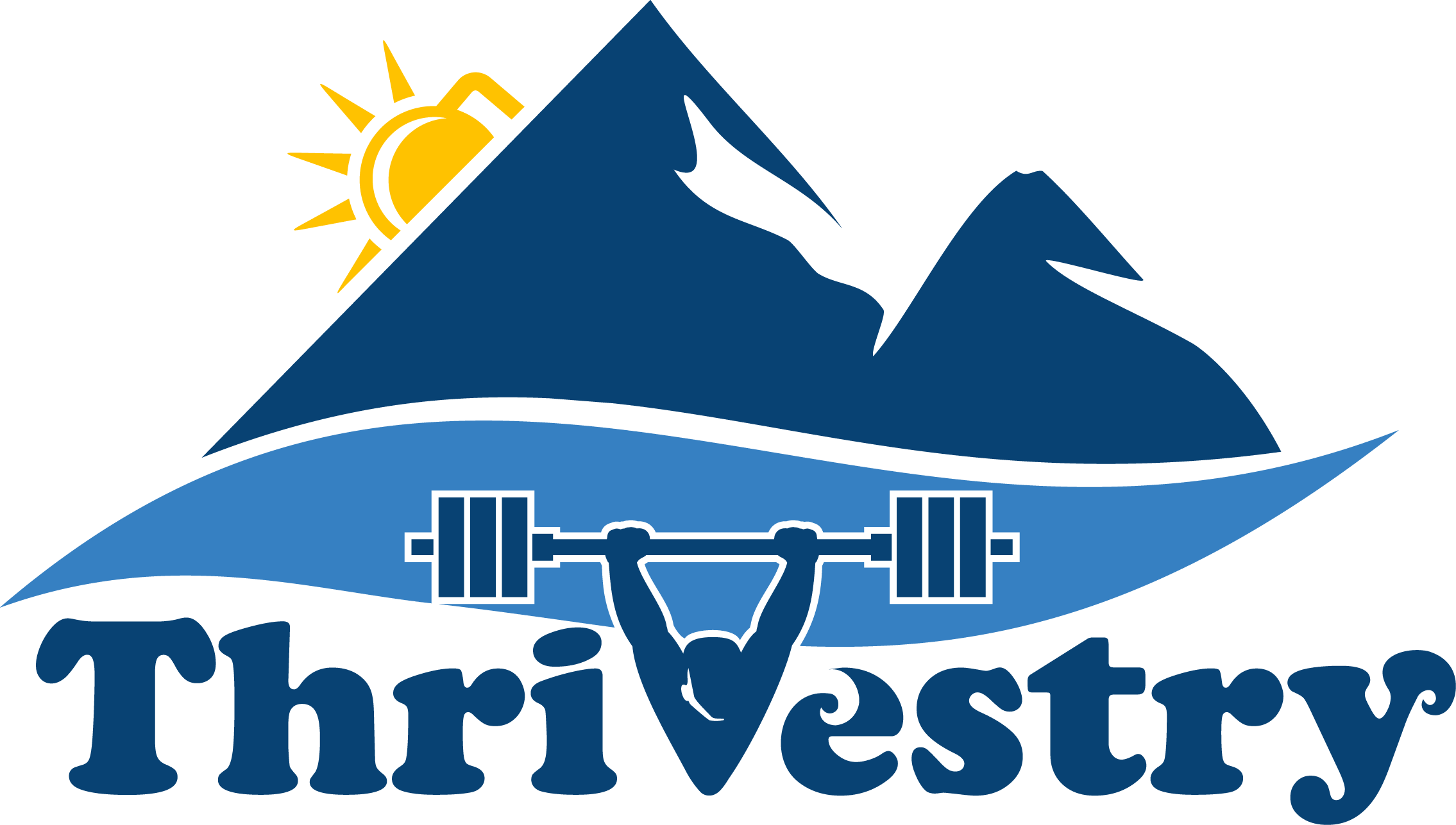
2 comments
I just checked out the Thrivestry blog about a 15-year CrossFit journey, and I'm truly impressed! The insights and experiences shared are so relatable and inspiring. Thanks for sharing such a real and valuable perspective on the CrossFit lifestyle. It's clear that a lot of heart and passion went into this, making it a great study for anyone on a fitness journey. Keep up the great work.
hi, i have experience great content on your site!!!
<a target="_blank" href="http://informationalvibes.com">crossfit</a>
Leave a comment